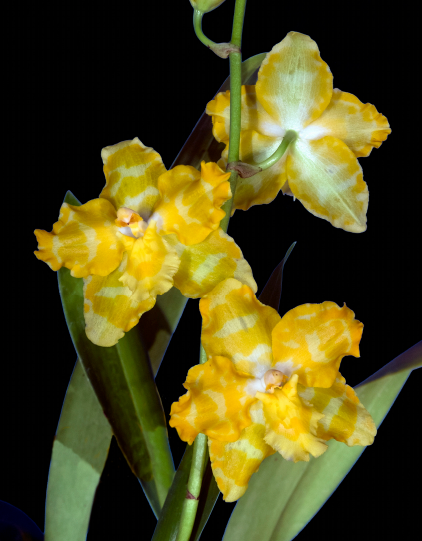Registered in 1920, Odm. Extraria (Odm. crispum × Odm. laeve) went nowhere. But a David Stead remake at Mansell & Hatcher introduced us to the alba strain of Odm. Extraria and it is a handsome thing. Bob Hamilton secured one of the remakes and has used it cleverly. He may also have made a misstep. As Bob's missteps are rare, read on and be reminded that orchid hybridizing has many traps. The first hybrid we have bloomed a ton of is Odm. Extraria alba × Oda. (Odm. Parade × Oda. George McMahon) + Oryzalin. They are floriferous, 100% albas, shapely, with many tending greenish especially when the flowers are fresh. I became immediately fascinated with the hybrid. But....... both the diploid and tetraploid forms are not really acceptable in their flower longevity. The tetraploids last longer, of course, but still not long enough and there's little less attractive to my eye than an inflorescence that is essentially dying in the middle. Then there is the crossing pictured, Odm. Extraria alba × Oda. George McMahon where 25% come as alba yellows. Some of this cross also have flower longevity issues and some do not. So what's going on? Well it's all quite simple when you think it through. Oda. George McMahon is a fertile triploid. I suspect that the flower life of Odm. Extraria alba is not generous. So when two diploid gametes match up, the resultant diploid progeny have fairly shortlived flowers. But when Oda. George McMahon produces a n+n+n gamete and this seems to happen fairly frequently, the resulting 4n seedling has much more Oda. George McMahon influence and it lasts a much longer time. That's my rationalization of what is happening but someone who knows more about genetics may see things differently.
 Photography credit: Andy Easton
Photography credit: Andy Easton
Hybridizing Notes: Odm. Extraria × Oda. George McMahon
Oncidium Allianceby Andy Easton
Originally published in The International Odontoglossum Alliance Journal , Supplement Spring 2020 in 2020
Posted by Sys Admin over 5 years ago.This article references Odm. Extraria, Oda. George McMahon, Odm. Parade.
Article Blog Article Index
Share on Social Media:
New Topics
- David George asked question Odom's Fascination - an unusual orchid in category General Discussion
- Carol Holdren asked question Grow Tent in the Garage in category General Discussion
- David George asked question rlc Caotan Beauty found at Home Depot in category Cattleya Alliance
- Kristin Dorris asked question Odontocidium Orchid fungus? in category General Discussion
- Maria Fernandez asked question Wild. Lisa Devos in category Dendrobiums
New Comments
- Carol Holdren commented on topic "rlc Caotan Beauty found at Home Depot " by David George
- Carol Holdren commented on topic "Odom's Fascination - an unusual orchid" by David George
- Dr. Florian Wolf commented on topic "Wild. Lisa Devos" by Maria Fernandez
- Michael Valcarcel commented on member plant Rlc. Chief Takanaka by Walceli Muniz Valverde
- Michael Valcarcel commented on member plant Rlc. Montana Spirit by Michael Valcarcel
- Michael Valcarcel commented on member plant Ctt. Blazing Sun by Michael Valcarcel
- Michael Valcarcel commented on member plant Bc. Spotted Clown by Michael Valcarcel
- Maria Skrypnyk commented on member plant Yamadara Redland Sunset by Maria Skrypnyk
- André Pessina commented on topic "Odontocidium Orchid fungus?" by Kristin Dorris
- Linda Hartman commented on topic "Image of a plant please" by Leshya Perkins
- Paul Reavis commented on orchid Milt. Kismet
- Christiaan Viljoen commented on member plant Psh. fragrans by Christiaan Viljoen
- Christiaan Viljoen commented on member plant Z. maculatum by Christiaan Viljoen
- Christiaan Viljoen commented on member plant C. Gaskell-Pumila 'Azure Star' by Christiaan Viljoen
- Robert H. Findlay commented on member plant Rlc. Joy Sokabe var. Volcano Queen by Sally K
- James Lunsford commented on member plant Lc. Sagarik Wax 'African Beauty AMO/AOS x Blc. Cherry Suisse'Kauai' HCC/AOS var. Cattlyea 'Hybrid ' by James Lunsford
- John Varigos commented on orchid Bulb. schwarzii
- Linda Hartman commented on topic "Issue with Blc. Ben O'Neil "Jubilee" by Glenda Ratliff
- Henry Shaw commented on member plant Ons. Catatante 'Los Roble' by Henry Shaw
- Mary Lane commented on member plant Den. Tianmu Canary by Terre Moore